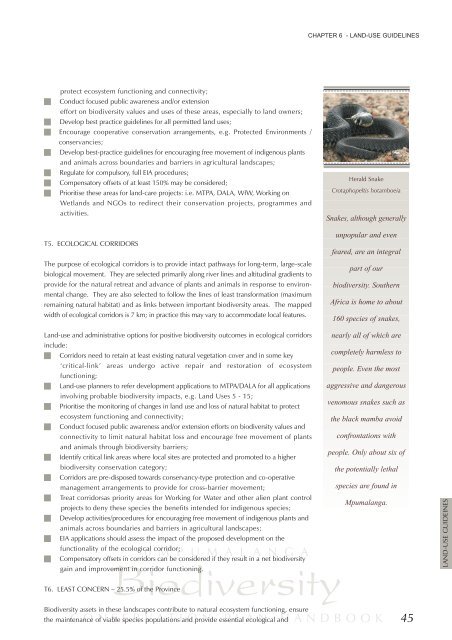Mpumalanga Biodiversity Conservation Plan Handbook - bgis-sanbi
Mpumalanga Biodiversity Conservation Plan Handbook - bgis-sanbi
Mpumalanga Biodiversity Conservation Plan Handbook - bgis-sanbi
You also want an ePaper? Increase the reach of your titles
YUMPU automatically turns print PDFs into web optimized ePapers that Google loves.
protect ecosystem functioning and connectivity;<br />
Conduct focused public awareness and/or extension<br />
effort on biodiversity values and uses of these areas, especially to land owners;<br />
Develop best practice guidelines for all permitted land uses;<br />
Encourage cooperative conservation arrangements, e.g. Protected Environments /<br />
conservancies;<br />
Develop best-practice guidelines for encouraging free movement of indigenous plants<br />
and animals across boundaries and barriers in agricultural landscapes;<br />
Regulate for compulsory, full EIA procedures;<br />
Compensatory offsets of at least 150% may be considered;<br />
Prioritise these areas for land-care projects: i.e. MTPA, DALA, WfW, Working on<br />
Wetlands and NGOs to redirect their conservation projects, programmes and<br />
activities.<br />
T5. ECOLOGICAL CORRIDORS<br />
The purpose of ecological corridors is to provide intact pathways for long-term, large-scale<br />
biological movement. They are selected primarily along river lines and altitudinal gradients to<br />
provide for the natural retreat and advance of plants and animals in response to environmental<br />
change. They are also selected to follow the lines of least transformation (maximum<br />
remaining natural habitat) and as links between important biodiversity areas. The mapped<br />
width of ecological corridors is 7 km; in practice this may vary to accommodate local features.<br />
Land-use and administrative options for positive biodiversity outcomes in ecological corridors<br />
include:<br />
Corridors need to retain at least existing natural vegetation cover and in some key<br />
‘critical-link’ areas undergo active repair and restoration of ecosystem<br />
functioning;<br />
Land-use planners to refer development applications to MTPA/DALA for all applications<br />
involving probable biodiversity impacts, e.g. Land Uses 5 - 15;<br />
Prioritise the monitoring of changes in land use and loss of natural habitat to protect<br />
ecosystem functioning and connectivity;<br />
Conduct focused public awareness and/or extension efforts on biodiversity values and<br />
connectivity to limit natural habitat loss and encourage free movement of plants<br />
and animals through biodiversity barriers;<br />
Identify critical link areas where local sites are protected and promoted to a higher<br />
biodiversity conservation category;<br />
Corridors are pre-disposed towards conservancy-type protection and co-operative<br />
management arrangements to provide for cross-barrier movement;<br />
Treat corridorsas priority areas for Working for Water and other alien plant control<br />
projects to deny these species the benefits intended for indigenous species;<br />
Develop activities/procedures for encouraging free movement of indigenous plants and<br />
animals across boundaries and barriers in agricultural landscapes;<br />
EIA applications should assess the impact of the proposed development on the<br />
0 M P U M A L A N G A<br />
functionality of the ecological corridor;<br />
<strong>Biodiversity</strong><br />
Compensatory offsets in corridors can be considered if they result in a net biodiversity<br />
gain and improvement in corridor functioning.<br />
T6. LEAST CONCERN – 25.5% of the Province<br />
<strong>Biodiversity</strong> assets in these landscapes contribute to natural ecosystem functioning, ensure<br />
the maintenance of viable species populations and provide essential ecological and<br />
CHAPTER 6 - LAND-USE GUIDELINES<br />
Herald Snake<br />
Crotaphopeltis hotamboeia<br />
Snakes, although generally<br />
unpopular and even<br />
feared, are an integral<br />
part of our<br />
biodiversity. Southern<br />
Africa is home to about<br />
160 species of snakes,<br />
nearly all of which are<br />
completely harmless to<br />
people. Even the most<br />
aggressive and dangerous<br />
venomous snakes such as<br />
the black mamba avoid<br />
confrontations with<br />
people. Only about six of<br />
the potentially lethal<br />
species are found in<br />
<strong>Mpumalanga</strong>.<br />
CONSERVATION PLAN HANDBOOK 45<br />
LAND-USE GUIDEINES

















